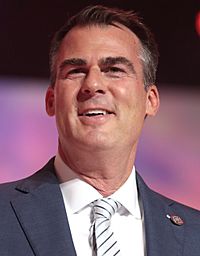Governor of Oklahoma facts for kids
Quick facts for kids Governor of Oklahoma |
|
|---|---|

|
|
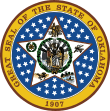
|
|
| Government of Oklahoma | |
| Style |
|
| Residence | Oklahoma Governor's Mansion |
| Term length | Four years, renewable once |
| Inaugural holder | Charles N. Haskell |
| Formation | November 16, 1907 |
| Succession | Line of succession |
| Deputy | Lieutenant Governor of Oklahoma |
| Salary | $147,000 (2013) |
The governor of Oklahoma is like the chief executive officer of the state of Oklahoma. They are the main leader of the state's government. The governor makes sure that Oklahoma's laws are followed and that the state runs smoothly. They also lead the Oklahoma National Guard when it's not working for the national government.
The governor has a four-year term. They give a "State of the State" speech each year to the Oklahoma Legislature. They also present the state's yearly budget.
The job of governor was created in 1907. This was when Oklahoma officially became the 46th state in the United States. Before 1907, the western part of Oklahoma was called Oklahoma Territory. It had a territorial governor chosen by the U.S. President. The eastern part was known as Indian Territory. This area was set aside for Native American tribes.
The current governor of Oklahoma is Kevin Stitt. He is a member of the Republican Party. Governor Stitt was reelected in 2022. His current term ends on January 11, 2027. He cannot run for governor again after this term.
Contents
Oklahoma's Governor: A Look Back
Early Days: Oklahoma Territory
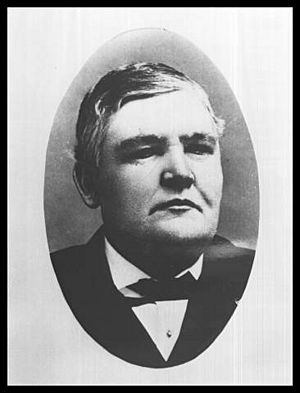
Before Oklahoma became a state in 1907, it was divided into two main parts. The western part was the Oklahoma Territory. The eastern part was the Indian Territory. The Indian Territory was mostly independent. The Oklahoma Territory, however, was managed by the U.S. President.
The Oklahoma Territory had a government similar to a state. It had a legislature (lawmakers), a supreme court, and a governor. The U.S. President chose the territorial governors. They served four-year terms. But the President could replace them at any time.
The territorial governor was the top leader. They could reject laws passed by the legislature. They also appointed people to lead government departments. The governor was also the leader of the local military, called the militia.
George Washington Steele was the first governor of the Oklahoma Territory. He served from 1890 to 1891. He stopped the legislature from moving the capital city from Guthrie. He also helped start what are now the University of Oklahoma and Oklahoma State University.
Frank Frantz was the last governor of the Oklahoma Territory. He served from 1906 to 1907. He tried to become the first elected governor of the new state but did not win.
From Territory to State: The Governor's Role Changes
When Oklahoma became a state in 1907, the new Oklahoma Constitution created the office of state governor. This new role was similar to the territorial governor. However, it had more rules and limits. This was done to prevent too much power in one person's hands.
Oklahoma's first state governor was Charles N. Haskell. He served from 1907 to 1911. He was a strong leader. But in the years after him, the Oklahoma Legislature made the governor's job less powerful. Two governors, Jack C. Walton and Henry S. Johnston, were even removed from office.
In 1931, William H. Murray became governor. He helped the governor's office regain its power. As Oklahoma grew, the governor's role became more important. The governor gained more influence by appointing people to lead state agencies.
For many years, a governor could not be elected for a second term right away. But in 1966, the state constitution changed. This allowed governors to serve two terms in a row. This is similar to how the U.S. President serves.
How Oklahoma's Governor Is Chosen
Governor Elections: What You Need to Know
The people of Oklahoma vote directly for their governor. This election happens in November every four years. The person with the most votes becomes governor. If there's a tie, the Oklahoma Legislature chooses the winner.
To be governor, a person must be a U.S. citizen. They must be at least 31 years old. They also need to have lived in Oklahoma for at least ten years before running.
The governor's term starts on the second Monday in January. A person can serve no more than two terms in a row. In 2010, voters decided that a person can only serve a total of eight years as governor in their lifetime.
Taking the Oath: A Governor's Promise
When a governor takes office, they say a special promise called an oath. This oath means they promise to support the U.S. Constitution and the Oklahoma Constitution. They also promise to do their job well and not take any illegal money.
Recent Election: 2022 Results
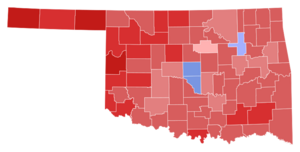
| 2022 Oklahoma gubernatorial election results | |||||
|---|---|---|---|---|---|
| Party | Candidate | Votes | % | ±% | |
| Republican | Kevin Stitt | 639,484 | 55.45% | +1.12% | |
| Democratic Party (UnitedVotes = 481,904 | Joy Hofmeister | 41.79% | -0.44% | ||
| Libertarian | Natalie Bruno | 16,243 | 1.41% | -2.03% | |
| Independent | Ervin Yen | 15,653 | 1.36% | N/A | |
| Total votes | 1,153,284 | 100.0% | N/A | ||
What the Governor Does: Powers and Duties
Leading the State: Executive Powers
The governor is the "Chief Magistrate" of Oklahoma. This means they are the main leader of the state's executive branch. They make sure that state laws are carried out. The governor can issue "executive orders." These are like special rules that have the power of law.
The governor is also the state's chief "peace officer." They lead state and local police. If needed, the governor can call on the Oklahoma National Guard. This is to help enforce laws, protect public health, or stop major problems. The Adjutant General of Oklahoma helps the governor with military matters.
The governor also appoints people to fill empty state jobs. If an Oklahoma member of the U.S. Congress leaves office, the governor calls a special election. They can also temporarily appoint someone to a vacant U.S. Senate seat.
The governor works with other elected state leaders. These include the Lieutenant Governor of Oklahoma and the Attorney General of Oklahoma. The governor also appoints a secretary of state. The governor has a group of advisors called the Oklahoma State Cabinet. Each member leads a state department.
The governor also helps create the state's yearly budget. This budget is presented to the Oklahoma Legislature in February. After lawmakers agree, the governor signs the budget into law.
Making Laws and Justice: Legislative and Judicial Powers
The governor plays a big part in making laws. Every bill passed by the Oklahoma Senate and Oklahoma House of Representatives goes to the governor. The governor can sign it into law or veto it. A veto means the bill is sent back to the legislature. Lawmakers can override a veto with a two-thirds vote.
The governor has a special power called the "line-item veto." This lets them approve parts of a spending bill while rejecting other parts. The governor also suggests new laws. They do this in their yearly "State of the State" speech.
The governor can call special meetings of the legislature. During these meetings, lawmakers can only discuss topics the governor suggests. If there's a disagreement between the two houses of the legislature, the governor can make them take a break.
The governor also has a role in the state's court system. They appoint six members to the Oklahoma Judicial Nominating Commission. This group helps choose judges for Oklahoma's highest courts. If there's an empty spot on the Oklahoma Supreme Court, the governor chooses one person from a list of three nominees.
The governor can also grant pardons. A pardon forgives someone for a crime. They can also reduce sentences. To do this, the governor usually works with the Oklahoma Pardon and Parole Board.
Working with Others: Foreign Relations
The governor is Oklahoma's main representative to the rest of the United States and the world. They negotiate deals between Oklahoma and other states or countries. The governor speaks for Oklahoma's interests. However, they cannot make treaties with other nations. The U.S. Constitution prevents this.
The governor might speak to the United States Congress or the U.S. President. This is to discuss national issues that affect Oklahoma. They also promote Oklahoma's businesses and products to other states and countries.
Handling Emergencies: Special Powers
If there's a natural disaster or other emergency, the governor gets special powers. This is under the Oklahoma Emergency Management Act of 2003. The governor or the legislature can declare a state of emergency.
During an emergency, the governor can take control of important state resources. These include food, water, and transportation. They decide how these resources are used. The governor also leads all emergency forces. This includes the Oklahoma National Guard and police.
The governor can order people to evacuate. They can also control traffic and public gatherings. They are responsible for caring for people affected by their orders.
State and local officials must cooperate with the governor during an emergency. If an official does not obey, the governor can remove them from office. However, the governor cannot remove elected state leaders or judges.
When acting during an emergency, the governor is usually protected from lawsuits. This means they are not held responsible for losses or injuries. This protection does not apply if the governor acts with extreme carelessness or on purpose.
Working with the Lieutenant Governor
The lieutenant governor of Oklahoma is elected at the same time as the governor. But they are not chosen as a team. Currently, Governor Kevin Stitt and Lieutenant Governor Matt Pinnell are both from the Republican Party.
Sometimes, the governor and lieutenant governor are from different political parties. This has happened several times in Oklahoma's history.
The governor can appoint the lieutenant governor to their cabinet. For example, Governor Mary Fallin once appointed Lieutenant Governor Todd Lamb to a role in her cabinet.
The lieutenant governor can also become "Acting Governor." This happens if the governor is out of the state or cannot do their job. When acting as governor, the lieutenant governor has all the governor's powers. This includes signing laws, making appointments, and calling out the National Guard.
The Governor's Office
 |
|
| Agency overview | |
|---|---|
| Formed | 1907 |
| Preceding agency | |
| Headquarters | Oklahoma State Capitol Oklahoma City, Oklahoma |
| Employees | 39 unclassified |
| Annual budget | $1.98 million |
| Minister responsible |
|
| Agency executive |
|
| Website | Office of the Governor |
The Office of the Governor is the state agency that helps the governor. It includes the governor's staff. This staff works in the governor's offices in the Oklahoma State Capitol in Oklahoma City and in Tulsa, Oklahoma. They also work at the Oklahoma Governor's Mansion.
In 2013, this office had a budget of about $1.98 million. This money pays for staff salaries and for running the governor's offices and the mansion.
Where the Governor Lives: The Mansion
Since 1928, Oklahoma governors have lived in the Oklahoma Governor's Mansion. Before that, governors lived in different places. The first governor, Charles N. Haskell, even lived in a hotel. The Oklahoma Legislature decided to build an official home in 1927. The mansion was finished in 1928.
The mansion was designed in a Dutch-Colonial style. It uses Carthage limestone on the outside. This helps it match the Oklahoma State Capitol building nearby. The state spent $100,000 to build and furnish it.
The mansion is about 14,000 square feet. It has 12 rooms, including a library, dining room, and five bedrooms. It also works as a museum. It displays old items and artwork that show Oklahoma's history and culture.
Who Takes Over: Succession Line
If the governor cannot do their job, someone else takes over. This can happen if the governor is removed from office, resigns, dies, or leaves the state. The lieutenant governor is the first person in line to take over.
If the lieutenant governor also cannot serve, the president pro tempore of the state senate is next. The Speaker of the Oklahoma House of Representatives is third in line.
If all these officials cannot serve, an "emergency interim successor" takes over. This person can act as governor during an emergency. However, they do not get the title of governor unless there's a major disaster.
Order of Succession
Here is the order of who takes over if the governor cannot serve:
| # | Office | Current Officer |
|---|---|---|
| May succeed to governorship | ||
| Governor of Oklahoma | Kevin Stitt | |
| 1 | Lieutenant Governor of Oklahoma | Matt Pinnell |
| 2 | President Pro Tempore of the Senate | Lonnie Paxton |
| 3 | Speaker of the House of Representatives | Kyle Hilbert |
| May serve as Emergency Interim Successor | ||
| 4 | State Auditor and Inspector | Cindy Byrd |
| 5 | Attorney General | Gentner Drummond |
| 6 | State Treasurer | Todd Russ |
| 7 | State School Superintendent | Ryan Walters |
| 8 | Labor Commissioner | Leslie Osborn |
| 9 | Corporation Commissioner (by length of tenure) | Todd Hiett |
| 10 | Kim David | |
| 11 | Brian Bingman |
Timeline of Oklahoma Governors
| Timeline of Oklahoma governors |
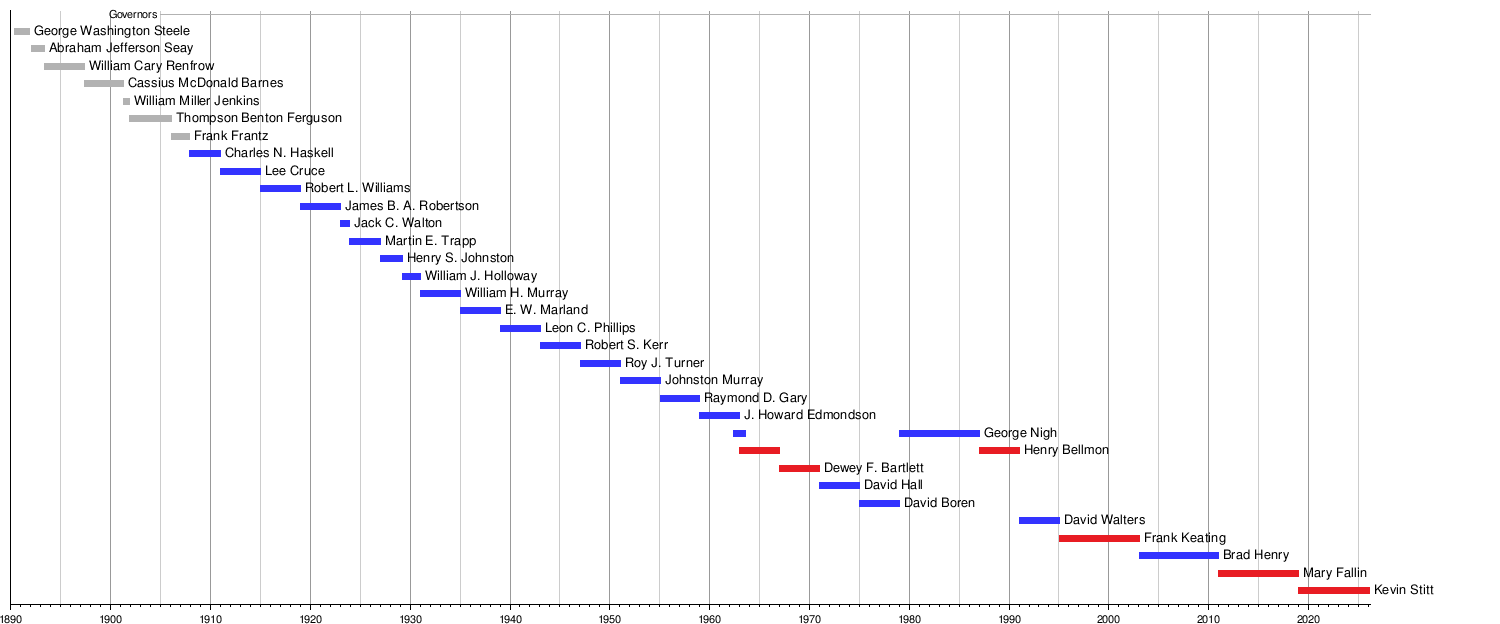 |
See also


